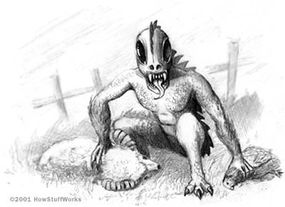[ad_1]
Mystery animals have captured the imagination and curiosity of people worldwide for centuries. The potential existence of such creatures in the modern world continues to inspire passionate debates as well as new tales and legends.
1. Marozi
With a maned lion’s face fronting a jaguar-like body, the Marozi (also known as the spotted lion) was reported several times in the 1930s in Kenya’s mountains but hasn’t been mentioned much since.
The Natural History Museum in Great Britain is said to be in possession of the spotted skin of a marozi, but many experts think the specimen represents a jaguar that bred with common, spotless plains lions.
2. Kamchatka Giant Bear
Swedish zoologist Sten Bergman, working in Russia’s Kamchatka Peninsula in the 1920s, discovered a paw print that measured a full square foot, suggesting a bear of remarkable size.
Similar sightings tell of an ursine almost twice the size of a typical North American grizzly bear, measuring 6 feet at the shoulder. Some Russian biologists believe there is a small group of Kamchatka Giant Bears that survived the most recent ice age.
3. Bigfoot
Bigfoot, also known as Sasquatch, is a big, hairy, two-legged beast that arose in North America, and first received the “Bigfoot” nickname in California in the late 1950s. What started with a flurry of local stories turned into a full-fledged media sensation and ultimately a legend that’s now known around the world.
Many people claim to have caught glimpses of Bigfoot, and the Patterson-Gimlin film, which supposedly shows one creature fleeing through the forest, is probably the most iconic bit of evidence in the entire library of 20th-century cryptozoology.
4. Yeti, aka Abominable Snowman
The Himalayan Mountains are reportedly home to the Yeti (or in Western culture, the Abominable Snowman), a bear-like or ape-like creature that’s been part of Eastern lore for centuries. Covered with long hair and built for rugged, cold environments, the Yeti is as evasive and mysterious as Bigfoot.
5. Skunk Ape
Bigfoot’s smelly Southern cousin has been reported a number of times in Florida’s swamps, most convincingly in 2000 by a couple who took an excellent snapshot of what looked to be a 6-foot-6-inch (2-meter) orangutan. The picture didn’t capture its scent, of course, but the couple attested to its atrocity.
6. Lizard Man
This scaly green hominid, the resident mysterious beast of Escape Ore Swamp in South Carolina, has long been at the center of local lore. While many consider the creature a hoax, others swear they’ve encountered it face to face.
Lizard Man has had several brushes with fame: A local radio station once offered $1 million for a live capture, and in 1988, a South Carolina Republican leader labeled Lizard Man a staunch Democrat.
7. Jersey Devil
According to most reports, New Jersey’s cryptozoological curiosity has wings, a horse’s face, a pig’s hooves, and a kangaroo’s body. The legend of the Jersey Devil was born in the 1700s — based on a tale of a cursed baby-turned-demon that flew off into the night — and boomed in the early 1900s, with people seeing it all over the state.
To this day, people report Jersey Devil sightings, mostly in the spooky Pine Barrens of southern New Jersey. While some locals think the creature is truly a supernatural beast, others say it’s probably a misidentified sandhill crane.
8. El Chupacabra

Latin America’s legendary “goat sucker” is a fanged and clawed beast that performs vampirism on livestock.
The first accounts of its victims — often goats, chickens, horses, cows and even domestic pets — were reported in the 1950s by farmers who found animals drained of blood, with several large puncture marks.
Some who have allegedly sighted the chupacabra describe it as a short, kangaroo-like monster with oversize teeth and an oval head, but others liken it to a large reptile or bat.
9. Kraken
The Kraken is a legendary monstrous creature in the deep ocean waters near Scandinavian regions. It’s described as an enormous, octopus-like animal that’s big enough to attack ships and frighten sailors.
This one might have basis in reality, thanks to the existence of giant squids (a former cryptid) that can grow up to 50 feet (15 meters) long.
10. Loch Ness Monster
Also known as Nessie, the Loch Ness monster is another world-famous creature that’s appeared in countless headlines and movies. It’s an ancient legend, too, appearing in historical records dating to 1,500 years ago. It’s supposedly a large marine animal with a slender neck that lives in Loch Ness, a 23-mile (37-kilometer)- long lake in Scotland.
Nearly 800 feet (244 meters) deep in some places, the lake (the largest body of fresh water in the United Kingdom) would make a sufficient hiding place for a shy creature, but aside from a few famous (and blurry) photographs and unreliable eyewitness accounts, there’s no proof that Nessie exists. A 2019 Washington Post article says scientists now think Nessie might have been a giant eel.
11. Tahoe Tessie
Deep in Lake Tahoe on the California-Nevada border lurks a storied sea creature that’s the Sierra Nevada cousin of the Loch Ness Monster. It’s alleged that after a submarine expedition, undersea explorer Jacques Cousteau said, “The world isn’t ready for what’s down there.” (He could, of course, have been referring to anything odd.)
Popular descriptions portray Tessie as either a freshwater relative of a whale or a 20-foot (6-meter) sea serpent with a humped back.
12. Mogollon Monster
In eastern Arizona there’s a long, rocky ridge, called the Mogollon Rim, that runs deep through a thick forest. That’s the reported home of the Mogollon Monster, which is described as a tall, two-legged monster with thick hair and a rancid stench.
Although amateur hunters have produced various bits of so-called evidence over the past century, there’s no reason to think this famous cryptid really exists.
13. Champy
Like Tessie, Champy is named for the body of water in which it purportedly lurks — in this case, Lake Champlain, a body of water on the New York-Vermont border.
Several hundred recorded sightings typically describe the beast as a serpentlike black sea monster with scales, measuring about 50 feet (15 meters) in length. One investigative group believes the oft-sighted Champy is actually a surviving plesiosaur, a dinosaur that died off over 60 million years ago.
[ad_2]
Source link
